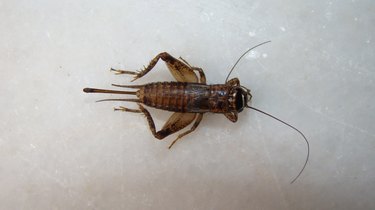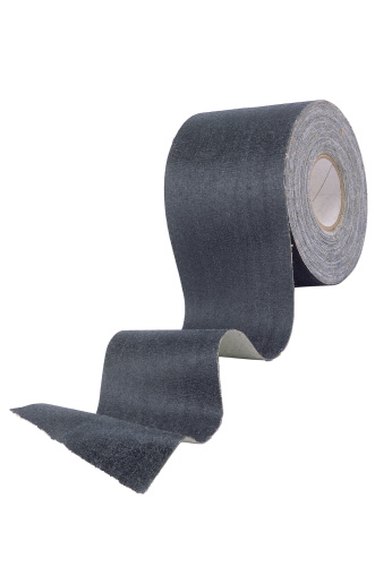
Things You'll Need
Cardboard
Scissors
Corn syrup
Cooking pot
Large spoon
Plastic knife
Duct tape
Wax paper or newspaper
Granulated sugar
Plain bread crumbs
Paper towel
Jar with lid

Glue traps or sticky boards are effective in trapping camel crickets, flying insects and even mice. Making your own cricket traps is inexpensive and works just as well as the commercial sticky boards to help get rid of any camel crickets. This insect has long legs that resemble spider legs and a humpbacked appearance. Camel crickets appear indoors during unusually rainy or hot, dry weather. They leave unsightly and unsanitary fecal smears and can damage clothing or other fabrics stored in boxes. Camel crickets are light brown or beige and have bands of darker colors on their bodies.
Corn Syrup Method
Step 1: Cut the Cardboard
Cut a piece of cardboard with scissors so that it is approximately 5 by 7 inches. Make three or four if the room is large or you have seen many of the insects.
Video of the Day
Step 2: Combine the Ingredients
Pour equal parts of corn syrup and water into a small cooking pot.
Step 3: Boil and Stir
Stir the mixture over medium high heat until it boils down and forms a thick, sticky paste.
Step 4: Bait the Trap
Spread the sticky mixture over one side of the cardboard with a plastic knife.
Step 5: Position the Trap
Set the glue trap in corners, behind appliances and other places you have spotted the camel crickets.
Step 6: Check the Trap
Inspect the traps daily and discard them once you capture any camel crickets.
Duct Tape Method
Step 1: Cut Out Cardboard Traps
Cut three or four pieces of cardboard with scissors so they are approximately 5 by 7 inches each.
Step 2: Wrap the Traps With Tape
Wrap duct tape around the cardboard so that the sticky side is facing up.
Step 3: Secure the Tape
Pull the tape around to the backside of the cardboard and overlap it slightly to make it stick. Continue wrapping the tape around the cardboard until it covers the entire thing.
Step 4: Place the Trap on Wax Paper or Newspaper
Set the trap down on a sheet of wax paper or newspaper. This prevents the backside from sticking to the floor.
Step 5: Situate the Traps
Place the traps in corners and anywhere else you have seen camel crickets.
Step 6: Monitor the Traps
Check the traps daily and discard them once you capture the insects. Make more traps if necessary.
Camel Cricket Live Traps
Notwithstanding the yuck factors, camel crickets actually do have a practical use. According to the Home Pest Removal website, you can catch crickets to use as very excellent fishing bait, if you catch them alive.
Step 1: Prepare the Jar
Poke holes in the jar lid. Screw the lid back onto the jar and set aside.
Step 2: Mix the Bait
Combine equal parts granulated sugar and plain bread crumbs. White or wheat bread crumbs work just fine. Avoid seasoned bread crumbs as crickets don't like some smells.
Step 3: Bait the Trap
Pour the mixture into a pile on the center of a small saucer.
Step 4: Finish the Cricket Trap
Cover the saucer lightly with a paper towel or newspaper. Place it where you've seen cricket activity, but out of the reach of children and pets. The mixture won't harm them, but you still don't want them snacking on your cricket trap.
Step 5: Open the Jar
Grab the jar and uncover the saucer. Do this early in the morning, before the sun comes up if possible. Most crickets are nocturnal, meaning that they go somewhere to hide and sleep through the day.
Step 6: Catch the Fish Bait
Catch as many of the crickets as you can. Put them into the jar and cover with the lid in between catches. These will make excellent fishing bait, or you can even use them to feed certain pet reptiles.
Tip
Prevent camel crickets by sealing cracks and gaps in doors, windows and the foundation of your home with weather stripping or caulking. Keep the basement area and crawlspaces dry since the insects are attracted to moist, cool areas. Store the remaining corn syrup paste in a glass jar with a lid to use in the future. If the glue traps become dusty, they are not as sticky or effective. Replace them with new traps once this happens.
Video of the Day